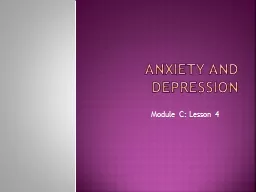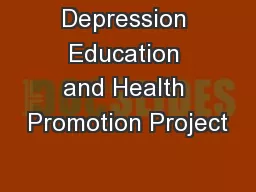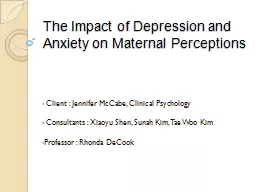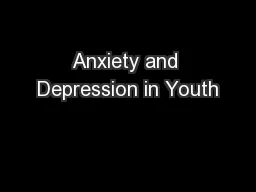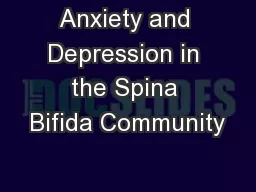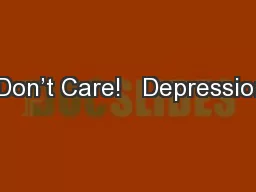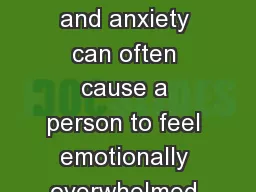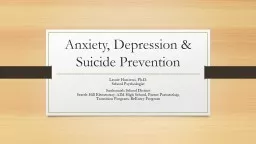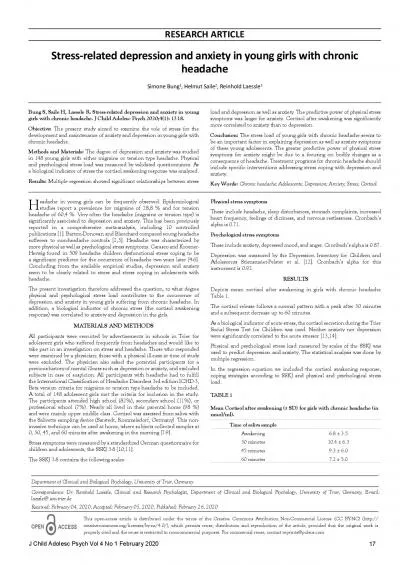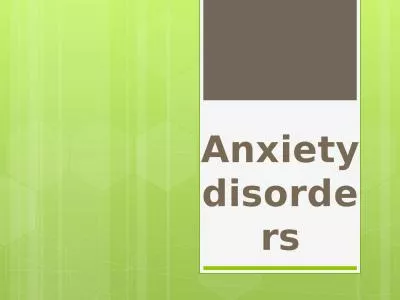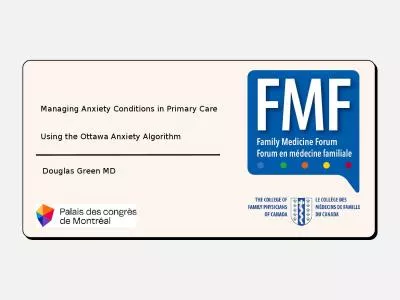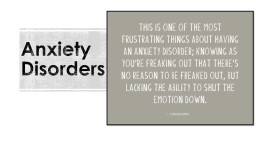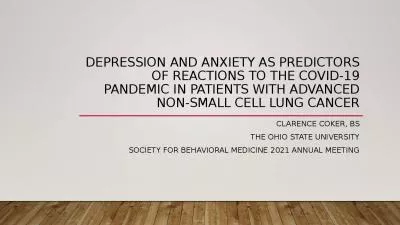PPT-Anxiety and Depression Module C: Lesson 4
Author : tatiana-dople | Published Date : 2018-11-08
A Report on Mental Illness in Canada Anxiety disorders affect 12 of the population Many do not seek treatment because Consider the symptoms mild or normal Symptoms
Presentation Embed Code
Download Presentation
Download Presentation The PPT/PDF document "Anxiety and Depression Module C: Lesson ..." is the property of its rightful owner. Permission is granted to download and print the materials on this website for personal, non-commercial use only, and to display it on your personal computer provided you do not modify the materials and that you retain all copyright notices contained in the materials. By downloading content from our website, you accept the terms of this agreement.
Anxiety and Depression Module C: Lesson 4: Transcript
A Report on Mental Illness in Canada Anxiety disorders affect 12 of the population Many do not seek treatment because Consider the symptoms mild or normal Symptoms interfere with helpseeking. They are very, very common.. What are the symptoms of depression?. What are the symptoms of anxiety?. How do you treat it?. Are antidepressants stimulants or depressants?. 1. Introducing Dopamine and Serotonin. Michelle Slivinsky, MA. UCONN Health Center. Department of Psychiatry. The Myth of the Bad Kid. . Handout from SAMHSA . (Substance . Abuse and Mental Health Services). . Caring for Every Child’s Mental Health Campaign. Client : Jennifer McCabe, Clinical Psychology . Consultants : Xiaoyu Shen, Sunah Kim, Tae Woo Kim. Professor : Rhonda . DeCook. Research Goal. . Figuring out how anxiety and depression is related to parenting stress and parenting stress coming from difficult child behavior. Andrew Hall, MD, FRCP. Child & Adolescent Psychiatrist . MATC. All Truth is God’s Truth. Arthur Holmes. (St. Augustine. ). Nobody ever sees truth except in fragments. Henry Ward Beecher. Recognizing mental health disorders in Children & Adolescents can be difficult because they are experiencing so many changes already.. By: Lauren Bendik, MSW. About Me. Professional. B.A. in Psychology from University of the Pacific, 2012. M.S.W. (Master’s in Social Work) with a mental health concentration and PPS credential from University of Southern California, 2015. Anxiety. , and A. pathy in Parkinson’s Disease. Rebecca Radue, MD . with Art . Walaszek. , MD . Introductions . Raised in Stevens Point, WI . G. raduated from UW School of Medicine and Public Health in 2014 . problems in . relationships. . It can be a helpless and lonely journey.. Through the “Finding ME”. programme, . a Dialectical . Behavioural. . Therapy treatment,. adolescents will learn to cope with depression and anxiety using the skills such as:. Laurie Harrison, Ph.D. . School Psychologist. Snohomish School District. Seattle Hill Elementary, AIM High School, Parent Partnership, . Transition Program, . ReEntry. Program. Snohomish School District . 13 pre-menstrual dysphoric disorder (PMDD) among undergraduate medical students: a descriptive study Shriniwas Choudhari, Rajshri, Sushma Inamdar, Narayan Mutalik, Vinod Akasalli, Bhaskar Mara Depart 18 Bung J Child Adolesc Psych Vol 4 No 1 February 2020 J Child Adolesc Psych Vol 4 No 1 February 2020 RESEARCH ARTICLE 17 eadache in young girls can be frequently observed. Epidemiological studies rep Anxiety is a normal response to stressful or fearful circumstances causing activation of neurobiological systems that allows an individual to adapt or manage the stressful situation.. Anxiety disorder occur when the anxiety is excessive leading to irrational. Douglas Green MD. Presenter Disclosure. Presenter: . Douglas Green. Relationships with financial sponsors:. •Any direct financial relationships, including receipt of honoraria:. . Not applicable. •Membership on advisory boards or speakers’ bureaus: . anx·i·e·ty. . /aNGˈzīədē/. A. feeling of worry, nervousness, or unease, typically about an imminent event or something with an uncertain outcome.. D. esire to do something, typically accompanied by unease.. Clarence Coker, BS. The Ohio State university. Society for Behavioral Medicine 2021 annual meeting. Background and Introduction. Anxiety and Depression play significant roles determining disease outcome in patients with advanced lung cancer (NSCLC).
Download Document
Here is the link to download the presentation.
"Anxiety and Depression Module C: Lesson 4"The content belongs to its owner. You may download and print it for personal use, without modification, and keep all copyright notices. By downloading, you agree to these terms.
Related Documents

